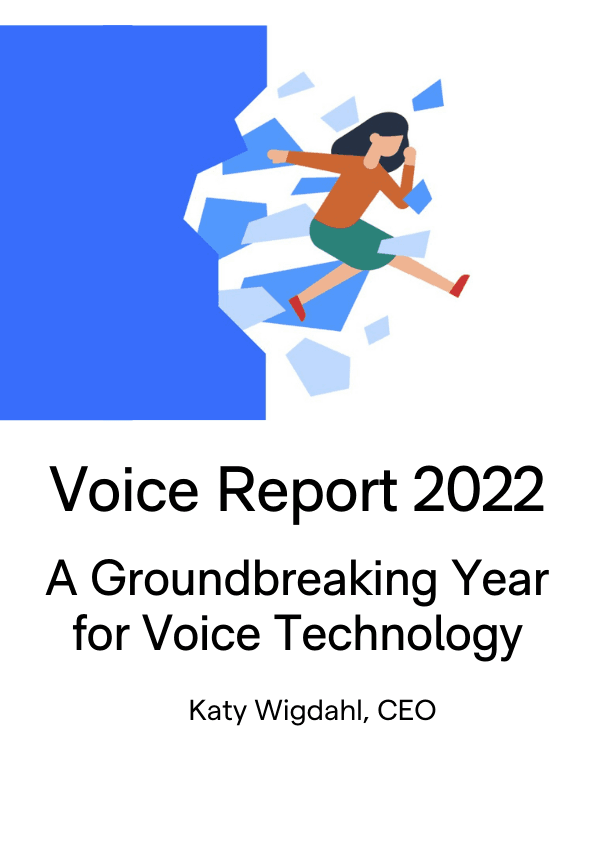- Blog
- Voice Report 2022: A Groundbreaking Year for Voice...
Feb 9, 2022 | Read time 4 min
Voice Report 2022: A Groundbreaking Year for Voice Technology
Speechmatics CEO, Katy Wigdahl, takes us through the Voice Report 2022 and what it means for voice technology and the voice industry at large.
Voice Report 2022: A Groundbreaking Year for Voice Technology
As the pandemic continues to dominate thoughts and the broader effect on society and business, here at Speechmatics, we've kept our focus as much on the future as the present. With significant shifts in voice technology taking place constantly, our annual Voice Report – which looks at the shape of the voice industry as a whole – has delivered its key findings, showing the world how the industry is faring in the ‘new normal'.
The first thing to note is that the deep tech ecosystem is in fantastic shape, despite the continued upheaval caused by the pandemic. The Atomico State of European Tech Report found there was nearly three times as much investment in the sector compared to the previous year, indicative of the ever-growing strength of the European tech industry’s close ties to academia and the talent emerging from it.
As we’ve always believed, there’s an ever-increasing appetite among investors for the world-changing potential of our technological developments.
Making Real Change
At Speechmatics, we’ve made it our mission to understand every voice. With this in mind, we made AI Bias the headline topic for this year’s Voice Report. We discovered a third of our respondents had personally experienced AI Bias when using voice technology. While the bias in technology is often discussed, it’s disappointing to see this not translating into real-life equity of experience for many users. There are positives to be found – a sizeable majority of people feel most voices are understood by voice recognition – but we feel it’s crucial we dig down into the specifics in order to make tangible change.
It was also clear accents and dialects are by far the standout issues that need to be addressed by the voice technology industry. Machine learning models need exposure to as diverse a range of accents and dialects as possible, to better understand all voices. There is no catch-all solution, but developments in self-supervised learning can play a critical role in closing the gaps in these areas.
The Report also shows adversity is continuing to fuel innovation. Over a third of respondents said that COVID-19 has affected their voice strategy and that the forced digital transformation of the last two years has had a seismic effect. We see this as all industries are looking for ways to circumvent obstacles set by the pandemic.
Respondents indicated that banking and healthcare were set to be the most significant growth industries for the use of voice technology, a marked change from the telecommunications industry’s prominence in this regard in previous reports.
The Impact of Self-Supervised Learning
Many within our industry (45 percent) are still unfamiliar with self-supervised learning technology and the transformative impact it will have. By learning using unlabeled data, self-supervised models vastly increase the training data available. At Speechmatics, this translated into the data we train our models on jumping from 30,000 hours to millions of hours. Increasing the awareness and usage of this technology will play an essential role in tackling bias across all technology fields.
Accuracy remains the top priority for many. There are some really positive trends to be seen in this area, especially a breakthrough in languages other than American English. This has resulted in overall growth in use cases for voice technology and reduced the accuracy gap among different demographics. This expectation of better accuracy can be seen in the shifting demand for specific languages. Our Voice Report found that Cantonese and Brazilian-Portuguese topped the list for most requested languages. In the years to come, it will be encouraging to see the widespread impact of other languages drawing level with the quality of American English.
The last few years have seen a massive uptick in the use of voice technology, and I’m proud of the role Speechmatics continues to play in that development. In 2020, half of all searches across the internet were voice-based, and this trend shows no sign of abating. As we know, increasing the accessibility of voice technology is crucial in driving wider adoption in the future. We need to tackle bias head-on and make the most of recent innovations in the space, such as self-supervised learning.
Breakthroughs like this, powered by innovative teams like ours, will play critical roles in ensuring everyone – regardless of their background – will be able to make the most of what voice technology has to offer, both personally and professionally.
Here’s to the future.
Katy Wigdahl, CEO, Speechmatics